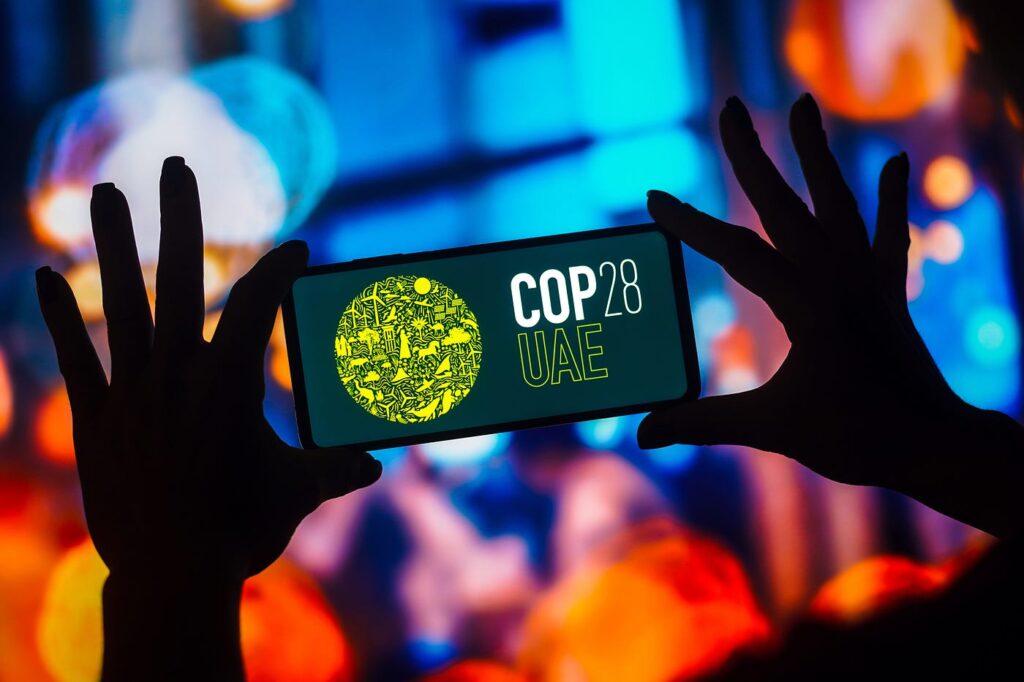
The COP28 Climate Change conference in Dubai is rapidly approaching and already making headlines. The media buzz is especially focused on the energy sector, who will now have a seat at the UN negotiating table.
Energy companies have opportunities to proactively shape their media reputation ahead of the conference. But that attention may bring new challenges and risks. So it’s important for energy communicators to be prepared for potential criticisms they may face.
To surface these risks, PublicRelay examined the media landscape for energy companies ahead of COP28. We drew on a sample of top stories in September and October 2023 about the conference.
Here are five PR risks energy communicators must prepare for ahead of COP28:
1. Watch out for concerns about competing interests
Climate advocates are skeptical of oil & gas’s involvement in COP28. Al Gore recently slammed the conference’s appointment of Sultan al-Jaber, the CEO of the Abu Dhabi National Oil Company, as COP28 president.
Wider oil & gas involvement may fuel fears that the sector is attempting to capture and obstruct global climate progress. That was the most prevalent and wide-reaching concern in the media. Some activists went so far as to demand boycotts of the conference.
2. Anticipate scrutiny about the scope of climate pledges
Companies like Shell and TotalEnergies have rallied around a Global Decarbonization Alliance in the oil & gas sector. Championed by the COP28 president, this alliance commits reducing emissions from oil extraction. It also aims to reduce methane emissions and oil leaks.
Energy companies should expect criticism about the scope of those commitments. Critics highlight that they miss scope 2 and 3 emissions where the energy sector’s impact is greatest.
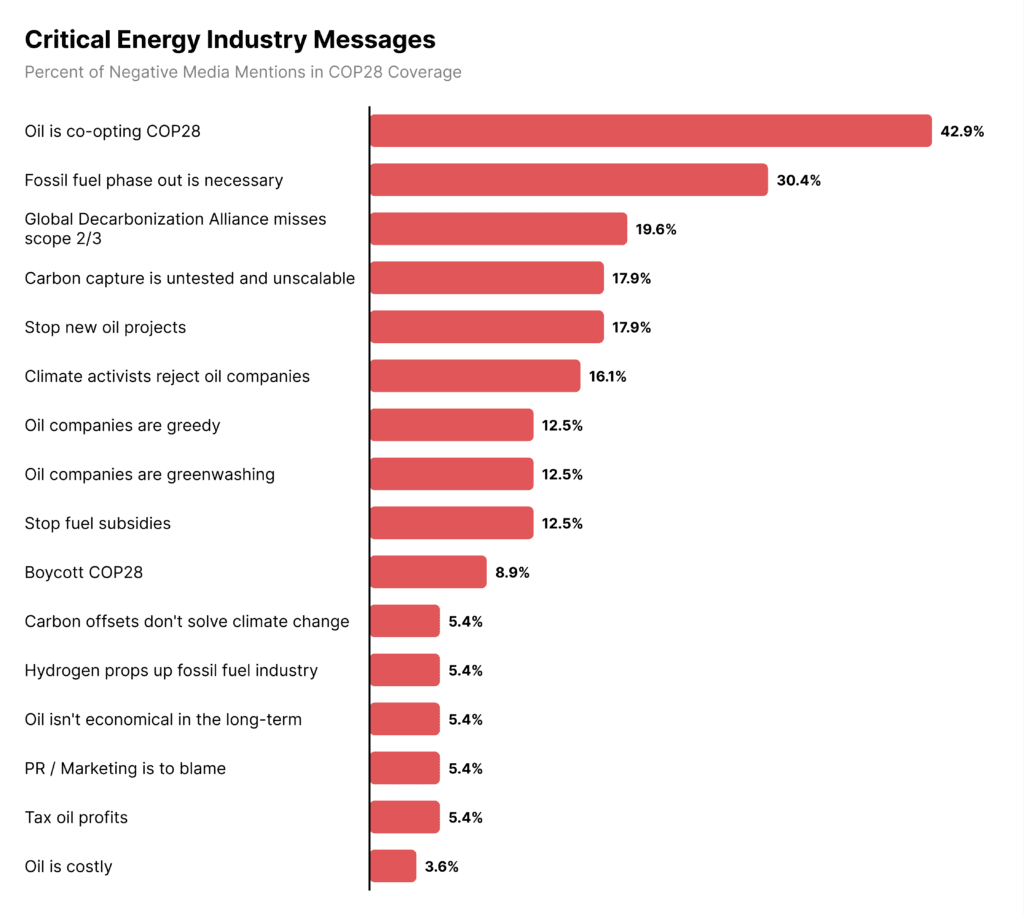
3. Be ready to defend future energy solutions
Climate advocates will likely be skeptical of new investments in new energy solutions. These range from carbon capture technologies to development of hydrogen fuel.
Some claim that carbon capture approaches are untested and unscalable. Some call out hydrogen development as simply re-entrenching reliance on fossil fuel.
4. Expect demands for financial commitments
Climate finance will be among the leading topics at COP28. Climate leaders are hoping to mobilize capital toward new climate-friendly infrastructure.
But some policymakers are also calling for prices on carbon, windfall taxes on energy profits, and a rollback of fuel subsidies worldwide. Energy companies may even be expected to arrive at COP28 with innovative approaches to carbon credits and pricing.
5. Manage perceptions from climate academics
Environmental activists are the biggest critics of energy companies. They speak loud and often.
Yet climate academics may be a bigger PR risk. They don’t criticize energy companies regularly. But when they do they receive higher engagement on average. Academics may be seen as more objective and credible to a wider audience.
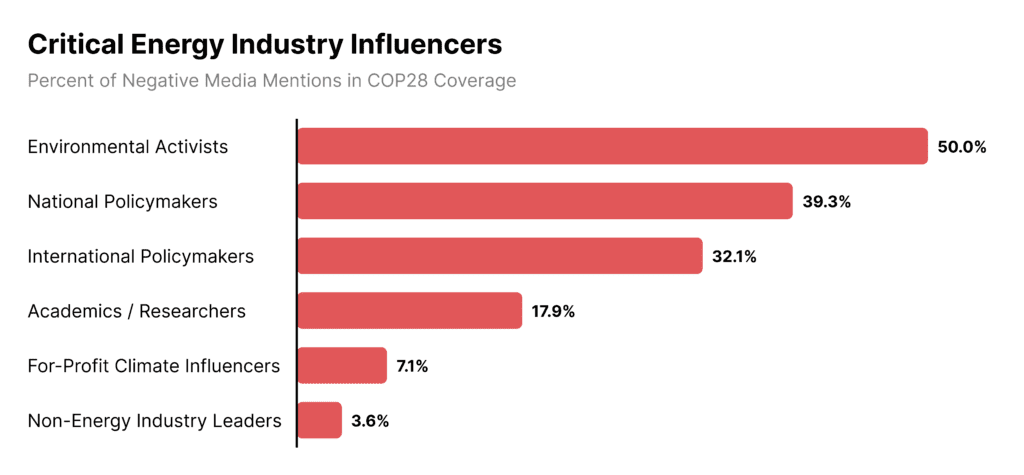
PR is in the spotlight
The stakes are high for energy communicators. Climate leaders will watch energy companies closely. Climate advocates may be quick to label the energy sector’s involvement in COP28 as nothing more than a greenwashing stunt.
Energy communicators must emphasize their genuine commitment to climate solutions. Make clear that oil & gas pledges may just be a first step in a larger green transition. Be prepared to showcase tangible investments in new and viable energy solutions. Offer support to innovative financing arrangements to position yourself as a forward-looking business.
Platforming third-party support is also necessary. Engage credible experts that can objectively support the energy sector’s efforts. Play up support from climate leaders like US climate envoy John Kerry and the Environmental Defense Fund’s Amanda Leland. Those influencers may be more hopeful that energy’s presence at COP28 can move climate progress forward.
Read Next: Improve Your ESG Communications Strategy

This year’s COP28 Climate Change Conference in Dubai is going to make headlines. Unlike prior years, global energy companies will have a seat at the negotiating table. With no less than the future of UN climate change policy up for debate, the stakes are high for energy communicators.
The energy sector’s involvement at the conference presents reputational challenges and opportunities. So it’s crucial for energy communicators to proactively shape their media reputation.
PublicRelay sought to understand the media landscape for energy companies ahead of COP28. We analyzed a sample of top stories in September and October 2023 about the conference. We also focused on the media’s coverage of major energy companies around COP28.
Here are five PR strategies for energy communicators ahead of COP28:
1. Seize the Spotlight on Energy Solutions
The COP28 news cycle will undoubtedly revolve around energy solutions. Energy-focused articles were most prevalent and mostly positive. They also had among the highest reach and social engagement.
Emphasize your company’s innovations in new energy areas. Positive energy stories focused on the development of renewables like solar and wind. They also discussed the growth of new technologies like carbon capture and hydrogen.
2. Embrace Climate Finance
While energy solutions led the media conversation, climate finance generated just as much social engagement.
Position your company as a leader in financing the transition to a greener future. Highlight investments in new energy solutions. Play up support for innovative approaches to carbon credits and taxation. This will reinforce your image as a forward-thinking business.
3. Capitalize on the Intersection of Climate and Global Health
Global health is an emerging topic in the climate conversation. It didn’t appear often in the COP28 news cycle, but coverage was entirely positive and widely amplified.
Showcase your contributions to global health through environmentally sustainable practices and products. This approach will likely be well received. It may also garner high syndication and sharing.
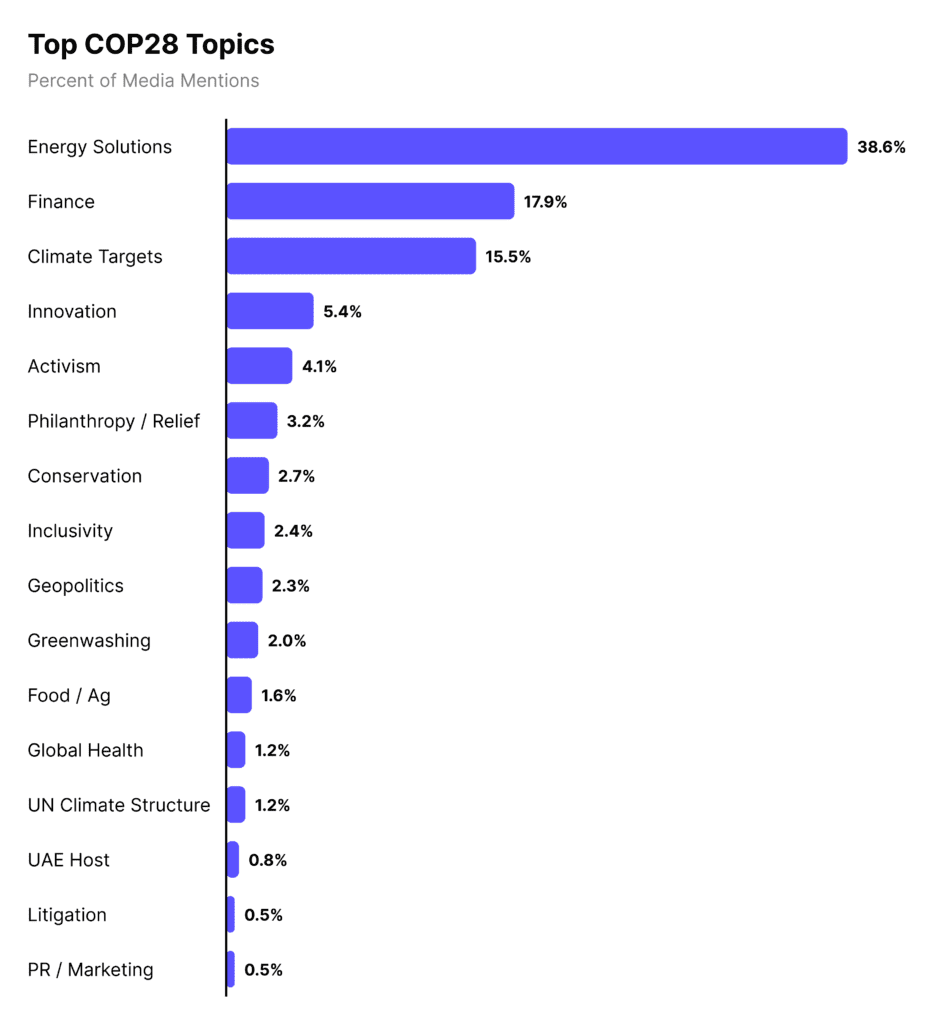
4. Support Oil & Gas’s Climate Commitments
Oil companies involved in COP28 have an opportunity to take on a greater role in climate action. Early media signals of the oil & gas sector’s climate commitments were positive.
Third-party climate influencers called for energy companies to lead on climate change. Some were optimistic about initiatives like the Global Decarbonization Alliance championed by COP28 president Sultan al-Jaber.
5. Frame your Climate Action as a Transition
Position energy decarbonization as a crucial first step in a just energy transition. Global demand for energy is increasing. But tangible actions by the energy sector can help mitigate the effect of emissions.
Sector-wide initiatives that were viewed positively included reducing methane from oil extraction. Preventing oil flares and leaks also had positive pick-up. These messages may resonate with the public. They can reinforce the sector’s role in meeting global energy demand responsibly.
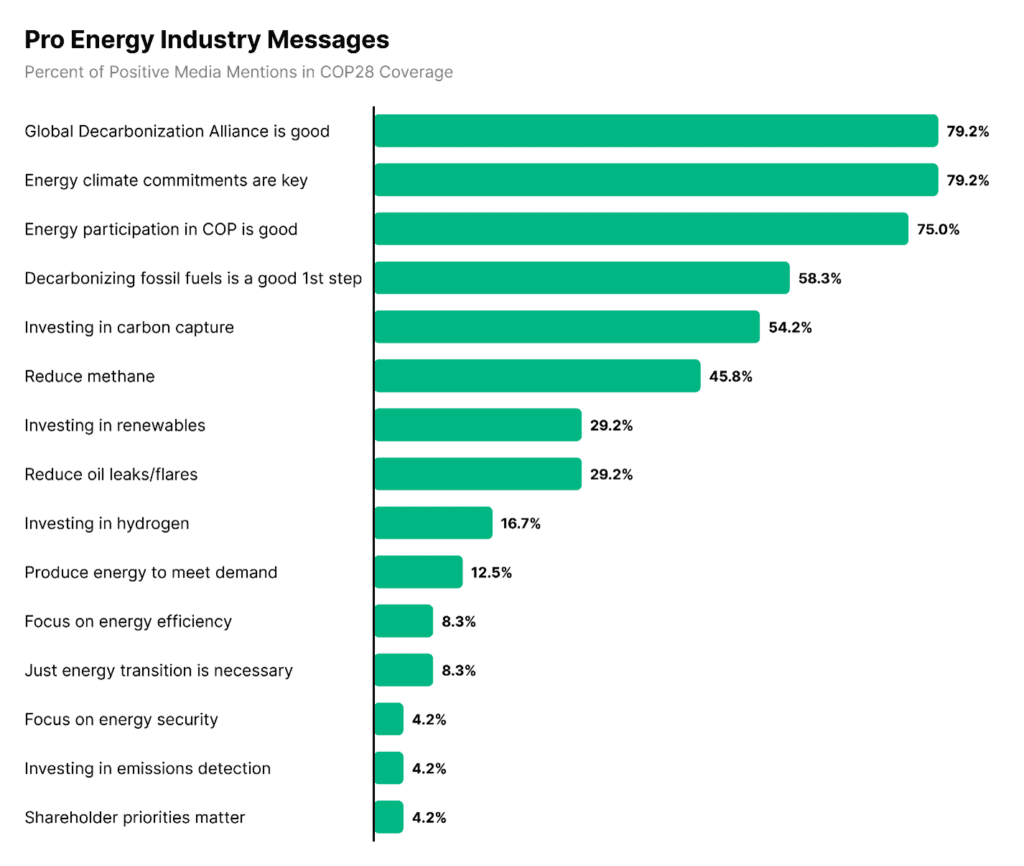
Managing Risks
Remember that addressing media scrutiny is important. Communicators should prepare to transparently respond to criticism at COP28. Expect accusations of energy companies co-opting global climate negotiations. Have a strategy to manage potential activist calls for boycotts of the conference.
Furthermore, acknowledge the scope of your emission reductions strategy. That’s especially when it comes to scope 2 and 3 emissions. Be ready to engage with politicians’ calls for taxes on energy profits. Highlight your commitments to invest in clean energy innovation worldwide.
COP28 is an opportunity for energy companies to reposition themselves as leaders in the global transition to a sustainable energy future.
Energy communicators must capitalize on emerging positive narratives and address challenges head-on. This can help their companies shine at COP28 and beyond.

Employer brand – your company’s reputation as a place to work – goes beyond impacting recruitment efforts. It’s an essential facet of your overall corporate reputation and can even influence consumers’ purchasing decisions.
You may think a satisfied workforce translates into a strong workplace reputation, but employee experience and employer brand aren’t always aligned. And that disconnect can come down to your communications.
However, employee brand ambassadors can help bridge the gap.
Engaging your employees as brand ambassadors can be one of the most powerful methods for improving public perceptions of your company’s workplace culture and managing your reputation.
What is an Employee Brand Ambassador?
A brand ambassador is an employee who promotes a company’s employer brand to their personal networks, usually via social media. As a prerequisite, they often have substantial social followings and online conduct that aligns with the brand’s values.
Traditionally, brand ambassadors were “influencers” – usually celebrities or individuals with significant name recognition – unaffiliated with the company they were paid to endorse (think Kiera Knightley and Chanel).
But rather than using prominent figures as they do for product endorsements, companies often turn to employees to advocate on behalf of their workplace culture.
Why Recruit Employees as Advocates?
Communications teams should recruit employees as advocates because audiences view employees as authentic and trustworthy sources of insight into their company’s mission, values, and ethics.
Stephanie Genin, Global Vice President of Enterprise Marketing at Hootsuite, explains that “brands are seeing value in influencer marketing because consumers are more influenced by an authentic, human communication than by corporate jargon.”
Not only does the public have more trust in perceived “normal” people, but the 2019 Edelman Trust Barometer found that 53% of all global audiences view employees as the most credible source of information when forming an opinion of a company. Another 78% agreed that “how a company treats its employees is one of the best indicators of its level of trustworthiness.”
In other words, employees are one of your most valuable resources for managing your workplace reputation.
Create an Employee Brand Ambassador Program
Consider engaging employees as brand ambassadors an element of your internal communications strategy.
And by launching an employee brand ambassador program, you can more effectively mobilize employee advocates to deliver the key messages that support your communications objectives.
Here are three ways to build a program optimized for impact:
Assess Your Employer Brand
Implementing an employee brand ambassador program is an opportunity to evaluate and understand your existing employer brand.
You must assess two aspects of your employer brand: employee experience and workplace reputation.
Employee Experience
Research your company’s employee experience on employee review sites like Glassdoor and social media platforms. For real-time feedback and suggestions for improvement, you can hold focus groups or conduct an employee feedback survey to assess your existing workplace culture.
Suppose it becomes evident your employees are unsatisfied with your company as an employer. This may be the place to start – by fostering a positive workplace environment and recognizing employee achievements – before recruiting ambassadors.
Alternatively, if your research indicates your company has successfully established a positive workplace culture, you can utilize this data to pinpoint your company’s strengths and identify themes for your ambassadors to highlight.
Workplace Reputation
To evaluate your external workplace reputation, you can use reputation polls or corporate reputation rankings to gain insight into public perceptions of your company as a place to work.
You can also use media analytics for a nuanced understanding of how the media covers your brand on various workplace reputational drivers that shape public opinions of your company culture.
Analyzing the data on your company’s workplace reputation against its employee experience will reveal any misalignment between the two and the workplace topics that could benefit most from your employee endorsements.
Recruit Volunteers
The value of employee endorsements resides in their personal experiences with the company and their willingness to advocate on behalf of the brand. Accordingly, enlisting brand ambassadors on a volunteer basis is crucial to the authenticity at the crux of their support.
Not only do audiences view employees as more trustworthy sources of information on a brand, but an authentic employee endorsement of your company as a workplace is one of the most impactful methods of verifying and reinforcing your desired employer reputation.
Encourage Ownership
Ramp up your internal communications and provide your team with frequent updates on company news and employee achievements, along with tools to simplify social sharing.
Encourage employees to take ownership of personal and company accomplishments by highlighting their role in successes and output. When employees are invested in their work and recognized for their performance, they will be more inclined to share positive company news with their social networks.
Take Control of Your Workplace Reputation
Engaging your employees as a part of your communications strategy will make your workplace messages more credible and ultimately improve public perceptions of your company culture.
At PublicRelay, we measure your workplace reputation as it’s represented in media coverage and on employee review sites, including Glassdoor and Indeed. With this insight, you can better understand your current reputation and benchmark your performance and the impact of your employee ambassador program in influencing your public perceptions of your brand. Start improving your workplace reputation now!

Once the public relations landscape is understood and your communications objectives are specified, the strategy development process begins. Of fundamental importance, stakeholder segmentation and media prioritization set the stage for strategy development (for both internal and external audiences). Once one understands the audience and the media to which they read, watch, and listen, the next step is to determine the messages to deliver.
Message engineering research helps pinpoint which messages perform best in terms of being compelling to the audience and credible coming from your organization. The result is stakeholder-centric communication that lays the groundwork for purposeful strategy and the tactics that bring the strategy to life. Unlike tactics, strategies remain in place over time and must support a variety of tactical bursts of activity to drive results. As such, research helps to inform the messaging and targeting approaches that are most likely to survive short-term market shifts to deliver positive and sustainable results.
Prioritizing Stakeholders and Targeting Media
Assumptions, intuition, and experience are not enough to make strategic decisions. Research, analysis, and evaluation must be conducted about stakeholders, including the media, to truly understand who they are and what messages will resonate.
It is vital to place significant focus on foundational research to discover which media perform best in terms of target stakeholder reach and penetration. To clarify, “reach” equals “circulation and audience.” “Penetration” means the “percentage of target stakeholders reached through an individual media outlet.” The media targeting process should involve some form of foundational research, which may include the following:
- Demographic/firmographic data available directly through attribution technology or indirectly through third-party data providers of media demographics.
- A survey to uncover the stakeholder’s awareness, attitudes, and behavior toward an individual medium as well as their media consumption preferences. These stakeholder attributes are further validated through a content analysis of news and social media.
- Social media analysis to profile stakeholders by their comments, how they self-identify, and the content they hyperlink through social sharing.
In addition to identifying the media with the highest potential, strategy research also reveals the relative authority and receptivity of journalists and influencers whose content appears in the media (traditional and social).
Using Media Analysis to Inform Your Communications Strategy
Professional communicators must find a balance among the media to identify just those which are:
- Important and engaging to the target stakeholder
- Most likely to cover news about your organization
- Least likely to cover competitors’ news
While an analysis of demographics and firmographics will tell which sources deliver the highest penetration among actual and potential customers, it will not indicate which media are more likely or less likely to cover a particular theme. However, a media analysis will tell which media are more receptive to the themes that matter most to you and your stakeholders. With this, content analysts can quantify the presence of intended and unintended messages, capture any reporting tendencies, and reveal a roadmap toward better results. This combination (the demographic audit and the media analysis) will reveal which media are considered the most credible, which match the often-subtle interests of the stakeholder, and which compel the highest levels of engagement among the targeted stakeholders. Combining media demographics and surveys with media analysis creates a basis for action and a foundation for success.
Message Engineering
Positioning or messaging is not a purely creative endeavor; research-based “message engineering” is an example of how science and creativity come together to result in more effective public relations. The science behind public relations enhances the creative process and helps illuminate the most compelling and credible messages. Message engineering is a data-informed stakeholder-driven process of developing a brand, an issue, or corporate positioning. When developing an optimal messaging strategy, research helps the communicator to:
- Understand what motivates the target to act
- Determine the degree to which the proposition can be made credibly by the organization and match the target stakeholder’s priorities and reality
- Evaluate how the competition or opposition performs against the same criteria
- Consider aspects of the messaging that hold the potential to be misinterpreted, hijacked, or somehow otherwise detrimental from certain perspectives
When one combines message engineering with media optimization, one reaches the intended audience in the best possible way.
Why Develop a Data-Driven Communications Strategy?
There are six reasons for establishing data-driven strategies:
- The data-based strategy development process enables more efficient tactical planning and execution.
- By putting stakeholders first, the strategy focuses resources on the objective rather than conventional wisdom, pure creativity, or vanity.
- It mitigates risk by pre-testing strategy before execution.
- It allows for a sustainable strategy.
- It provides a common language to gain alignment in advance among executives who sponsor or evaluate corporate communications performance.
- It creates alignment with peers across the enterprise and within the function, enabling the communications department to prosper.
Communications Strategy Development Methods
Methods of developing data-driven communications strategies include:
- Quantitative research (surveys) and qualitative research (focus groups) to uncover insights about the media consumption preferences of stakeholders and the messages most likely to resonate.
- Analysis of news outlets’ published articles and social media channels to determine what topics they cover and how they cover them.
- Media demographic audit to determine which media deliver the highest penetration among actual and potential customers, employees, and other targets.
- Social listening – in the form of a digital focus group or media analysis — to uncover insight into stakeholder interests, preferences, and behavior.
- Analysis of journalists and influencers to identify target intermediaries to deliver key messages to key audiences.
- Competitor analysis to gauge which strategies appear to be most effective among shared stakeholders.
- PR attribution analysis to identify which digital media and messages are most likely to drive click-through to the website and to track how people engage with the site (e.g., the pages they visit and the information they download).
Example: How a Data-Driven Communications Strategy Leads to the Right Messaging
A company is set to launch a new product to drive revenue for the company’s second-half financials. Thanks to the communications team’s social listening tools and traditional media analysis, the team can see security concerns are being raised around topics related to their new product. These insights are considered and alter how the product is communicated before launch, and a security focus is dialed up as part of the product benefits. Ahead-of-launch messaging is updated, and product benefits are re-ranked to highlight security. The communications team can report its role as part of the business outcome through predictive listening.
# # #
Mark Weiner is the Chief Insights Officer for PublicRelay and the author of “PR Technology, Data and Insights: Igniting a Positive Return on Your Communications Investment.”
Excerpt from “The Communicator’s Guide to Research, Analysis, and Evaluation,” originally published by the Institute for Public Relations in March 2021.
Editor’s Note: Interested in learning how you can demonstrate the value of your work? Read our guide to PR attribution!

In every business case, there is an objective: it might include generating a profit, attracting and retaining top talent, or giving back to a community. In every case, the goal is to build and reinforce relationships, reputation, and organizational performance. To advance an organization, professional communicators must clearly understand its aims to help the organization achieve its business objectives. While each component of the research-based public relations continuum is integral to achieving positive results, the initial stage of objectives-setting research is the most important. Yet, it is also the most frequently overlooked. Setting objectives is the foundation for the entire public relations program on which strategy, execution, and evaluation are formed. Setting and then exceeding objectives that are meaningful, reasonable, and measurable support the communicator’s ability to demonstrate the value of public relations and provide forward-looking insights.
Writing Meaningful, Reasonable, and Measurable Objectives
The difference between a goal and an objective is that goals are relatively vague but represent an overall outcome the public relations professional wants to achieve. They should align with the business goals and reflect the broad aspirations of the organization and often appear in the form of “vision statements” and “statements of purpose.” On the other hand, objectives are measurable and focused, serving as a guide and allowing professionals and others to see how and when they have been met or exceeded. To elevate public relations, one must generate and demonstrate a positive return. While demonstrating the value of public relations is among the profession’s most vexing challenges, the best path is also the most direct: work with executives who control the budget and evaluate performance to set objectives that are meaningful, reasonable, and measurable.
Therefore:
- Meaningful objectives align with organizational goals and the priorities and preferences of executives in charge of evaluating and/or funding public relations.
- Reasonable objectives are openly negotiated with the executives who evaluate and fund public relations programs and confirm what the public relations function can realistically be expected to deliver.
- Measurable objectives ensure that communications performance can be easily quantified regardless of whether the person evaluating performance understands public relations or not. Measurable objectives specify:
- What should be achieved (e.g., “to increase awareness of our socially responsible investment funds”)
- The target stakeholder (e.g., “female millennials”)
- The time frame (e.g., “from June to August”)
- The desired measurable change (e.g., “raise awareness by 7%”)
Objectives should follow the SMART (specific, measurable, attainable, relevant, and time-bound) format, which allows for the creation of strategies and tactics that clearly align with each objective and the ability to later demonstrate a return on expectations.
Unlike indeterminate objectives like “generate buzz,” “break through the media clutter,” and so on, the objective is specific and clear, such as: “to increase awareness of our socially responsible investment funds by 7% among female millennials from June to August.”
Why Set Objectives?
Research takes the emotion out of objective setting. There are six reasons for setting clear, concise, and pre-negotiated public relations objectives:
- Create a structure for prioritizing action among members of the communications team.
- Allow the team to stay focused and circle back to the objectives to ensure the strategies and tactics support achieving (and hopefully exceeding) the objective.
- Reduce the potential for disputes before, during, and after the program.
- Increase efficiency by concentrating resources where they will make a difference, thereby reducing waste.
- Help to form successful programs by focusing attention and action on those criteria by which the program will later be evaluated.
- Set the stage for evaluation by enabling public relations investment decision-makers to determine if the public relations program delivered on its promise.
Objective-Setting Research Methodologies
Research methods to inform objectives may include:
- Data or information gathered from conducting a public relations landscape analysis (i.e., market research, traditional media analysis, social media analysis, web analytics, and digital media attribution) to inform objective setting.
- Primary research (research conducted by the organization, such as surveys or focus groups with internal or external stakeholders) or secondary research (research that has already been conducted by the organization or another entity) that validates the problem or opportunity the objective seeks to address.
- Internal research to ensure that PR objectives align with overall organizational goals as determined through a review of the enterprise’s mission statement and publicly stated priorities.
- Leveraging prior company data as a baseline that objectives will be measured against.
Defining Metrics and Key Performance Indicators
When setting objectives, it is important to define metrics and indicators that communicate success.
For instance, the example objective above seeks to “raise awareness of our socially responsible investment funds.” To one person, raising awareness might mean securing media placements about the investment funds. To another, it might mean surveying the intended target stakeholder (female millennials) to gauge if they are aware of the investment funds. Having a clear definition of the desired key performance indicators and how they will be measured helps to determine later the success of your efforts to meet or beat the objectives. Regardless, the metrics should be valid, meaning that they must actually measure what they are supposed to measure. For example, some may use impressions to measure awareness, which is not a valid metric for measuring awareness.
Differentiating Between Outputs, Outtakes, and Outcomes
When writing measurable objectives, it is important to recognize the difference between measuring outputs, outtakes, and outcomes. Ultimately, all are reflected in your objectives since they are interrelated.
Outputs
The number of communications deliverables the organization produces by using and resulting from a communications process; the number distributed and/or the number reaching a targeted stakeholder.
Example of an Output
How many internal messages did the organization send on a particular issue?
Outputs are a measure of production and distribution. They are focused more on what the organization does rather than how the program affects the attitude or behavior of the intended audience. Other important metrics include outtakes and outcomes, especially behavioral measures as communicators ultimately seek to ignite behavioral change.
Example Metrics Used to Measure Outputs
- Number of tactics, events, and materials produced, sent, or distributed (i.e., newsletters, brochures)
- Traditional and social media coverage, Share of voice Circulation/audience/reach
- Mentions
- Tone of coverage, intended and unintended message pull-through
Outtakes
Measurement and analysis of how stakeholders respond to programs, initiatives, campaigns, and content are foundational for optimizing and highlighting the value of public relations investments. Although many communications KPIs are more perceptual in nature (e.g., brand, reputation), outtakes are a key underpinning as they are clear and tangible (e.g., view, open, read, share, download, etc.). In this way, “outtakes” may be considered “short-term outcomes.” What did they take away from the communications program?
Example of an Outtake
The degree to which a stakeholder “received the message” is measured in terms of awareness, recall, understanding, and retention.
Example Metrics Used to Measure Outtakes
- Followers/subscribers
- Click-throughs
- Likes and retweets
- Engagement (i.e., comments, shares)
- Recall, awareness, understanding, and retention
- Web analytics (i.e., unique visitors, bounce rate, downloads, click-throughs)
- Open rate ratings/testimonials
- Viewership/readership
Outcomes
This is the ultimate goal and related KPIs to which leading senior communicators aspire. Outcomes are more macro and often more perceptual in nature. These often include a quantifiable change in awareness, knowledge, attitude, opinion, brand/reputation equity, and/or behavior levels that occur as a result of public relations programs, initiatives, or campaigns. Outcomes result in an effect, consequence, or impact of a set or program of communications activities or products and may be either short-term – even immediate – or long-term.
Example of an Outcome
Outcomes represent what’s on the minds of stakeholders, including awareness, preference, and purchase intention, for example.
Organizations should also think about the impact of a program on business outcomes, such as: How did the PR program affect people’s attitudes toward the company or its product because of public relations actions taken or tactics deployed? To what degree did PR contribute to attracting and retaining talent? How did PR improve the organization’s ESG investment rating?
Example Metrics Used to Measure Outcomes
- Awareness
- Knowledge/understanding
- Attitudes/opinions
- Reputation
- Trust
- Transparency
- Attendance/product/service
- Consideration
- Products/service preference
- Customer purchase/acquisition and retention
- Employee acquisition and retention
- Satisfaction
- Loyalty
- Advocacy (e.g., Net Promoter Score (NPS))
- Brand equity
- Brand valuation
- Behavior/sales
- Other behavioral changes (e.g., donate, vote, partner, policy change)
# # #
Mark Weiner is the Chief Insights Officer for PublicRelay and the author of “PR Technology, Data and Insights: Igniting a Positive Return on Your Communications Investment.”
Excerpt from “The Communicator’s Guide to Research, Analysis, and Evaluation,” originally published by the IPR in March 2021.
Editor’s Note: Interested in learning how you can demonstrate the value of your work? Read our guide to PR attribution!

Building your brand awareness takes time, especially if you rely on earned media to reach your audience. But you can optimize your public relations by integrating the PESO model into your communications strategy, which will help increase your reach to key stakeholders. This model showcases how your target audience receives information through multiple channels and why it’s necessary to get your brand messages in front of them.
What is the PESO Model?
The PESO model is a PR strategy that uses integrative communications to maximize audience reach efficiently and effectively. According to Gini Dietrich, author of Spin Sucks, each media type works independently and interlinks with the others. The idea of aligning content across platforms will allow you to reach your target audience more effectively through multiple connection points, ultimately expanding your communications reach.
Why is the PESO Model Important?
The PESO model is important because it gives communicators multiple avenues for reaching their audience, allowing them to rely on more than just earned media coverage. Utilizing more than one channel boosts your content and amplifies your message. By incorporating this model into your communications strategy, you can set goals to inform, inspire, build relationships with, and influence your audience.
Implementing this model not only offers several channels for sharing content but also provides means to measure your communications efforts and prove the value of your work.
How to Use the PESO Model in Communications
When considering how you can use the PESO model to accelerate your communications strategy, it is essential to consider your company’s objectives, your target audience, and what your competitors are doing. This insight will help you to determine which channels are best for sharing your message and what your target audience looks for on those channels.
Here is how you can use each facet of the PESO Model in your communications:
Paid Media
Paid media can help promote your brand messages by placing your content directly in front of your target audience. It includes sponsored content, advertising, paid search results, and sponsorships, but it doesn’t have to break your budget. Start by testing various types of paid content to determine which avenues have the greatest return for your brand.
Earned Media
Earned media is crucial to boosting your brand awareness. Creating newsworthy content, connecting with influencers, and understanding your target audience is vital to gaining earned coverage. Building relationships with your industry bloggers, influencers, and journalists who could share your brand messages will help them become familiar with your company and the value it offers your shared audience.
As you generate earned media coverage, your team can measure message pull-through to determine whether your brand values and messages have been communicated effectively. Then you can establish a strategy for future campaigns using knowledge of what did and did not work.
Shared Media
Shared media refers to content on any social media platform. It is an important tool for building brand awareness and allows you to create a sense of community around your brand.
For the best results, research each platform to see which ones work for your industry and target audience. Keep in mind that each platform features unique content types and favors specific methods of sharing. You will want to tailor the frequency of your posts, the format of your content, and even the time of day you share to each platform’s algorithm to effectively engage its audience.
After researching social platform best practices, you can start experimenting with content and testing the results.
Owned Media
Owned media is any content or platforms you have direct control over, including websites, newsletters, press releases, blogs, and social media channels. These media assets allow your team to take control of your brand narrative and produce content highlighting your key messages. When done right, owned media can even generate earned and shared media coverage.
Evaluate Your PESO Strategy
Once you implement the PESO Model, you can measure its effectiveness with media analytics. By identifying trends in your media coverage and evaluating metrics such as key message penetration, social engagement, and press release pick-up, you can refine your application of the PESO Model to improve your strategy going forward.
Using the PESO Model for Better Communications
Using the PESO Model will allow you to optimize your communications and boost your brand. By integrating the four media types, your team can establish consistent and authentic messaging that has a greater impact on your audience.
At PublicRelay, we provide highly accurate and nuanced media analytics with our hybrid approach using human expertise and advanced technology. We can help you identify communications trends and best practices, measure and benchmark your progress, and prove your impact, so you can more effectively reach your target audience and your communications goals. Click here to learn more!
Written by: Ilze Santare, Benchmark Analyst at PublicRelay

To succeed in Public Relations, you must apply what you learned in the previous year to improve your odds in the New Year. We recommend a PR Landscape Analysis as the best way to catalog, evaluate, and improve upon your situation. The analysis answers such questions as: What is the current environment? What place do we hold within this environment? Why is this so? Is it likely to continue? What do we need to know now to improve our position? Even if you think you know the answers, the current atmosphere indicates a need for each of us to consider such an analysis to reassess our current communications environment.
What is a PR Landscape Analysis?
The PR “landscape” of which we speak reflects your business landscape. It is comprised of external actors, like your customers, competitors, shareholders, regulators, journalists, social media influencers, and politicians, as well as local community groups in cities where you conduct business. It also incorporates the changing business, cultural, and societal norms that dictate what it takes to be an admired organization and preferred brand now. The “landscape” also includes internal stakeholders such as the senior executives who allocate funding for PR and evaluate PR programs, as well as employees and peers to address in-house factors such as new developments and other marketing communications initiatives within your organization.
A PR landscape analysis enables the communicator to:
- Assess strengths and weaknesses versus existing objectives, competitors, and past performance
- Detect and evaluate the viability of new PR opportunities
- Accurately forecast potential risks and opportunities
- Set objectives that are meaningful, reasonable, and measurable
- Adapt strategies and tactics to markets, trends, and stakeholder priorities
- Identify ways to differentiate your value proposition
- Reaffirm understanding and gain direction among internal stakeholders
- Evaluate competitors, opposition, and aspirational peers
Planning Your PR Landscape Analysis
To begin, you must fully understand your senior executives’ expectations, preferences, and values as they relate to public relations: what do they value most and least? And how do you perform against these priorities? To succeed, you must also uncover the specific metrics by which they choose to measure PR success (and yours). You must also reaffirm the professional attributes they consider most and least important, as well as how well you perform against those preferences. In a way, this may amount to initiating your annual performance evaluation early but, once you uncover their attitudes and preferences towards PR and your ability to deliver on their priorities, your path becomes very clear.
Five Steps for A Successful PR Landscape Analysis
The PR Landscape Analysis involves research and analysis to set the stage for what comes next: objectives setting, planning, activation, and evaluation. To accelerate your PR Landscape Analysis in pursuit of a fresh start, here are five basic steps to achieve your goal:
Set Your Objectives
The first step in the PR Landscape Analysis requires you to clarify your objectives for doing it in the first place. The most essential step in any discovery process is to know the purpose of the endeavor. What do you hope to learn? What questions must you ask and among which stakeholders to achieve your goal?
Define the Scope
The second step reflects your need to specify the scope of your analysis. Once you set your objectives for this endeavor, you must determine the breadth of your research. One meaningful factor to consider is the priorities of your organization. Does the organization aspire for some greater purpose beyond just “sales?” You must also factor in the priorities of your internal and external stakeholders. Internal stakeholders include executives with influence over PR funding and the evaluation of the PR function as well as employees and peers in adjacent departments.
The analysis should reveal the degree to which your messaging aligns with the objectives of your organization as well as the priorities of external stakeholders both domestically and internationally. What’s more, aim to gain new insights into your competitors’ activity and the extent to which they’ve succeeded or fallen short in reference to your objectives.
Understand Your Stakeholders
The third step in the process requires you to identify what you need to know about each stakeholder. For every group, you must seek to learn what’s important and how you’re performing on what’s important. For example, with media coverage and social media activity, assess message frequency, reach, tone, and the degree to which you delivered the intended message (as well as “unintended” and critical coverage). For customers, demographic and firmographic information helps to identify the media your stakeholders favor. Media analysis, social media listening, and surveys reveal the answers to these essential questions.
Start Your Research
Step four involves “digging deeper.” Once you understand the objectives, scope, and data intelligence you need, it’s time to conduct the research and probe the data with a variety of research tools and methods to gather insights and produce the analysis. You must also answer the essential quality-related question of “what’s good enough?” The research methods you employ can vary from free conference room brainstorms and Google searches to the use of secondary research, surveys, and media analysis. With the benefit of tools and research experience, you may conduct the research yourself or, if you have the resources and expect big changes in the upcoming year, you may hire an independent communications research provider who may be more objective and experienced in the process.
Analyze Your Data
Step five involves synthesizing and analyzing the data to uncover insights and explore implications. To generate additional insights, consider engaging colleagues from marketing and human resources before finalizing since they target similar audiences and may be working toward the same business outcomes as you. Only after thoughtful vetting, you should present to senior leadership to discuss findings and recommendations along with implications. Your leadership’s buy-in enables you and your communications team to proceed with minimal risk. Catalog any conclusions drawn from the PR Landscape Analysis meetings with top executives and get final authorization before executing the recommended steps.
PR Landscape Analysis for Better Communications
We operate in challenging times, but research and evaluation equip us to make better decisions under difficult circumstances.
# # #
Mark Weiner is Chief Insights Officer for PublicRelay and the author of “PR Technology, Data and Insights: Igniting a Positive Return on Your Communications Investment.”
Originally published in PRNEWS January 2021 issue.
Editor’s Note: At PublicRelay, our quarterly Benchmark report conducts an in-depth analysis of the communications of some of the world’s leading brands. Check out our Communications in Context series for insights into the PR landscape and a sample of the key insights from our latest Benchmark report!

In a world where PR campaigns compete to gain audience attention, using the right media outlet to access your target audience is vital. Once it is clear who your target audience is in terms of demographics – age, gender, location, etc. – you must learn how and where that audience consumes media and how best you can access them.
What is Targeted Media in PR?
Targeted media in PR is the list of media outlets or contacts you plan to direct your pitches to. The ideal target media includes those that will allow you to reach your audience with credibility and authenticity. Outlet or platform types (e.g., traditional print media, social media, broadcast, and digital media), individual publications, authors or journalists, and social influencers are all essential components of your targeted media list.
Why is Targeted Media in PR Important?
Targeted media in PR is important because coverage in the correct outlets can help your messages cut through the noise and engage your target audience. It will, in turn, help deliver your message directly to your audience and will assist in achieving your individual PR campaign goals.
How to Identify Your Targeted Media in PR
Identifying the correct media type will ensure that your messages reach your audience efficiently. Here are the steps you can take to determine the right media for your PR campaigns:
Determine Your Target Audience
The simplest way to determine your target audience is by breaking down a large group according to various demographics such as age, gender, disposable income, location, etc. Discovering your audience through social media and community groups can help you better understand who they are and how they engage with your organization or media content in general. Further, actively researching the media type your target audience engages with will help you to refine your targeted media list.
Establish the Goal of Your Content
Once you’ve pinpointed your target audience, you can evaluate outlets and media through the lens of what you want your PR to achieve. If your goal is to improve your brand awareness, focus on the media types that can support that, such as national publications with sizeable general audiences. Alternatively, let’s say your PR goal is to mobilize an audience to act by voting in a local election or donating to a cause, for example. This may be more effectively achieved through smaller localized publications or specific interest media outlets.
Research Media Contacts
Researching outlets and authors will provide valuable insights into the publications most suited to your PR campaign. Compile a list of metrics – covered topics, competitor coverage, and social media engagement – on each prospective outlet and journalist. PublicRelay, through extensive media research, has a database of outlets, authors, and influencers who comment on topics relevant to your industry. An in-depth database with details on relevant media contacts and capabilities for filtering by location, outlet size, reach, etc., can help you build a targeted media list that is adaptable to each PR campaign.
Compile a Targeted Media List
As mentioned by Forbes, you don’t necessarily have to limit yourself to one specific media source, and using a combination of outlets is often highly valuable. Your sources may include local or national newspapers, radio, trade, or technical magazines with a specific interest, local bloggers who are consumers of your product or service, and social media platforms where your audience can actively engage with your campaign.
Finding the right outlets to add to your list can be obtained by looking through previous press releases and researching what your competitors are doing and who they are engaging with their content on social media. A media list should be adaptive and will change over time, which will help you home in on the correct outlet at the right time, which can eventually build brand awareness on a local, national, or international level.
Build Relationships with Media Contacts
Establishing relationships with your media contacts will help you generate more earned coverage with less effort over time. According to LinkedIn, a positive step in creating such a relationship would be to develop a rapport before formally pitching to a potential media partner. By creating friendly relationships with journalists interested in your field and offering them content opportunities, they will begin to view you as a valuable resource. Most importantly, targeting the right journalists from the outset of a PR campaign will make your efforts at relationship building appear more authentic and set you up for long-term connections with authors interested in reporting on your industry.
Test and Measure
Once your campaign is up and running you can begin to assess its impact through several metrics such as tone, the volume of earned media content, and social engagement. Having analytics available to provide insights on sentiment, reach, and social engagement will allow you to assess your brand’s impact on your audience. Further, analyzing how the media discusses your brand against your messaging will help you to understand your message pull-through and, ultimately, the effectiveness of your targeted media list.
In addition to measuring the success of your campaign, media analytics will also highlight opportunities to create influencer partnerships and relationships with journalists who covered your brand or industry favorably.
Create Your Targeted Media List with Precision
Having great content that’s interesting and newsworthy is wasted if it doesn’t reach your target audience. The key to getting high-value earned coverage lies in targeting the right media sources that have effectively tapped into your audience. By choosing the outlets and journalists most appropriate to your PR campaigns, you can boost your brand’s visibility and improve its reputation.
PublicRelay can provide advanced insights on the outlets and journalists writing favorably about the topics and companies important to your brand, and provide data that can help you compile your ideal targeted media list. Click here to learn more!

On June 24, 2022, the U.S. Supreme Court ruling in the Dobbs v. Jackson Women’s Health Organization legal case effectively reversed Roe v. Wade (1973) and Planned Parenthood of Southeastern Pennsylvania v. Casey (1992). The decision to overturn the two landmark cases – which had established and affirmed a constitutional right to an abortion, respectively – now leaves it up to each state to regulate abortion access with the ability to go as far as banning it entirely.
As states react to the ruling – some with increased restrictions on abortion access and others with expansions to access – so does the corporate sector.
Companies Must Take a Stance
The issue of abortion rights is a divisive topic that many companies may prefer to leave to the public sector. But research shows that Americans want companies and their executives to take a stance on political issues, and the abortion debate is no exception.
The stakes are high, too. Not only will corporate responses have implications for companies’ reputations, but they will also impact employer brand as more employees, particularly Gen Z workers, will turn to employers for additional benefits to compensate for restrictive social policies.
Developing an Abortion Rights Communications Strategy
This means that your communications approach to abortion rights will likely become a significant factor in shaping your reputation going forward. And, while your company’s executives or board members may determine its position on abortion rights, the delivery is up to you.
So, how do you develop messaging on a sensitive social topic like abortion rights in a way that resonates with your audience?
How Social Media Analytics Can Illuminate the Conversation
While opinion polls are an excellent resource for gauging public sentiment on social topics like abortion, they often don’t capture the nuances of the broader discussions that can guide your messaging.
That’s where social media comes in.
Because social media platforms host a significant portion of the ongoing public discourse surrounding abortion rights, it contains a depth of data that goes far beyond the polls. Not only can social media analytics identify what people care about most at any given moment, but it can also uncover the subtleties of the discussion, highlighting how you can frame your messaging to cut through the noise.
At PublicRelay, we used social media sampling to analyze a random sample of 2,143 tweets (from a total of nearly 70k) from June 20 to July 3, 2022, containing keywords related to abortion and the U.S. Supreme Court’s overturning of Roe v. Wade.*
With this method, we tracked the Twitter conversation around abortion rights to gain an insight into audience perspectives and the messages that resonate.
Here’s what we found:
The Abortion Rights Twitter Conversation Reflects National Public Opinion
The abortion rights conversation exploded on Twitter immediately following the overturning of Roe v. Wade, and it’s a discussion that’s likely to continue.
Our Twitter sampling results closely align with the results of a May 2022 Gallop poll, with 57% of tweets opposed to overturning Roe and 37% in favor of the Court’s ruling.

Interestingly, pro-abortion rights messages have an outsized social reach. Tweets against overturning Roe reached an audience 5x the size of those in favor of overturning Roe. In other words, anti-abortion rights tweets have a much smaller following than pro-abortion rights messages.
How Abortion Fits into Healthcare is a Leading Message
On both sides of the debate, messages about whether abortion constitutes healthcare captivate a significant share of the Twitter audience.

The “abortion is not healthcare” message accounts for nearly a quarter of the anti-abortion rights Twitter audience. Meanwhile, “abortion is healthcare” is the second leading pro-abortion rights message – behind “overturning Roe restricts bodily autonomy” – and received significant Twitter audience reach.

The Focus on Company Actions is Likely to Grow
In the immediate aftermath of the ruling, most of the Twitter conversation focuses on the overturning of Roe itself. Though companies’ responses to the decision appear in only 2% of tweets, that is likely to change as more state laws take effect and corporate responses materialize. Ultimately, the public expects companies to react, and we anticipate the Twitter conversation to reflect that.
So far, company actions mentioned in abortion tweets include travel support for abortion care, data privacy related to abortion services, corporate support of politicians on either side of the abortion rights debate, and company statements.
Using Social Media Analytics to Improve Communications
Let’s examine how social media sampling insights can fill the gaps when refining your abortion rights messaging.
For instance, Morning Consult polling data indicates that U.S. consumers want brands to support abortion access. Its July 2022 survey results found that most respondents “favored companies’ declaring a pro-choice position: Nearly half (49%) said they support when companies make a statement in opposition to the decision, compared with 29% in support of a statement that endorses the ruling.”
This information may help a brand decide to vocalize its pro-abortion rights stance. But what’s the best way to do it?
Consider our finding that “abortion is healthcare” messages resonate with the pro-abortion rights Twitter audience, paired with evidence that more workers expect employers to offer health insurance covering contraception and family planning services. Messaging that highlights how the company intends to include support for abortion access as a part of its employee healthcare benefits will align with a prominent thread of the abortion rights conversation while bolstering the company’s employer brand.
Building a Strategy for Sensitive Social Topics
Companies will face increasing pressure to respond to the overturning of Roe v. Wade and other sensitive social issues. And, because of its implications for reputation, communications around these topics are best not left to trial-and-error.
As a communicator, you can build a strategy that uses data to direct your messaging and navigate even the most heated social topics.
At PublicRelay, we use human-augmented technology to analyze conversations surrounding broad social topics for concepts, sentiment, and trends to shed light on the complex social issues that impact your brand. Click here to learn more!
*The number of sampled tweets was stratified to be proportional to the raw volume of tweets each day, and retweets were excluded from the sample. The analyzed sample is representative of the overall Twitter conversation related to abortion and Roe during the two-week period with 95% confidence, given a 2% margin of error. Learn more about how we use social media sampling to extract statistically significant insights from Twitter data.

Editor’s Note: As our Chief Insights Officer, Mark Weiner, explains below, no PR measurement program is complete without benchmarking. But for truly relevant insights, you need a benchmark built around communicators. That’s why we launched the PublicRelay Benchmark so you can evaluate your PR performance against the world’s best communications. Preview a few of the media trends and insights from our Q1 Benchmark report now!
Media content analysis continues to be one of the most popular forms of PR research and evaluation. This approach involves the deconstruction of traditional and social media content to convert text, video, and audio content into actionable data representing individual messages as well as the names of spokespeople, opinion leaders, and influencers. Once converted to data, the researcher seeks to detect trends, uncover insights, and propose future action.
Thorough media analysis includes each of the following: quantitative analysis (frequency and reach); qualitative analysis (tone/sentiment and message delivery); comparative analysis (your performance versus other measures); and business impact (PR’s effect on revenue generation, efficiency, and cost avoidance). In this column, we focus on comparative analysis, commonly known as “benchmarking.”
Why Benchmarking Matters
Smart communicators use benchmarking to assess their environment, gain perspective, and refine for better results. Without the context of comparative analysis, one can pursue what seems like a proper PR plan by setting measurable objectives, developing data-informed strategy and tactics, and evaluating performance… and get everything absolutely wrong.
Imagine this scenario: a communicator sets an objective to improve by 20% over the previous period by generating 500 positive stories per month, 80% of which contain one or more key messages, and 20% of which appear in top-tier media. Sounds good. Even if they achieve all their objectives, they may hit their numbers and fail miserably. Why? Because their competitors aren’t idle: they may have generated 1000 positive stories per month, 90% of which contain three key messages and 40% of which appear in top-tier media. In the absence of competitive benchmarks, your program can only be partially informed and your advice to leadership will be inaccurate or irrelevant.
The Best Benchmarking Metrics
Benchmarking adds insights when done right. The best comparisons to include are:
- Performance versus objectives: Assuming you set measurable objectives at the start, good objectives answer “the what” (what are you measuring), “the when” (the period of activation), the “among whom” (the intended audience), and the “by how much” (the level of improvement). If among your objectives you see, “generate significant buzz,” “break through the media clutter,” or “raise media awareness,” you’re in trouble because they aren’t measurable.
- Performance versus competitors: One of the most compelling measures to management is whether (and the degree to which) you beat competitors. Even if you have many competitors, focus on those that matter most: the market-share leader, the most innovative, and the one that keeps the CEO up at night.
- Performance versus aspirational peers: There are times when your traditional competitive set may not provide the insights you need. Being the best performer among losers is no great distinction. In such cases, you may choose to add an “aspirational peer.” For example, nowadays almost every company competes for talent. Many companies compete for ESG investors regardless of sector. So even if you’re in financial services, you may want to benchmark against Salesforce; widely recognized as a top ESG company and innovator. Benchmarking against aspirational peers enables you to pursue “the best of the best.”
- Performance over time: If you set measurable objectives in the prior period, you can measure the degree to which you improved performance since then. Senior executives may not understand PR or the media, but they recognize continuous improvement. One wrinkle: the state of the media business portends great difficulty if you focus solely on quantitative measures: circulations are down and the emergence of “news deserts,” content sharing through common ownership, and bottom-line struggles for media around the world reveal fewer opportunities for media placements.
Even if your senior leadership knows little to nothing about public relations, all you may need to show is that you beat the competition, exceeded your objectives, and improved over last year to prove that you spent the organization’s PR investment wisely.
Improve Your Communications with Benchmarking
Benchmarking provides context and learning opportunities that enable you to be – or beat – the best. Like all communications research and evaluation, benchmarking takes place throughout the public relations cycle rather than at the end of a sequence. Benchmark early and often to guide your progress towards continuous improvement every step of the way.
# # #
Mark Weiner is Chief Insights Officer at PublicRelay. He is the author of “Public Relations Technology, Data and Insights” which is available for preorder now.
Originally published in PRNEWS March 2021 issue.